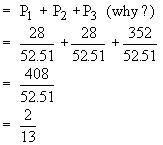|
Therefore , P (an ace or a king in the second draw)
= P (ace in first draw) . P (ace or king in the second
draw)
= 
(2) P (A) =  , if the first card is a king.
, if the first card is a king.
Now in the remaining lot of 51 cards, there are now 4 aces and 3 kings.

Therefore, P2
(an ace or a king in the second draw)
= P (a king in the first draw) . P (ace or king in
the second draw)
= 
(3) If the first draw shows neither an ace nor a king,
 [Note 52 - (4 kings + 4 aces) ] = 44.
[Note 52 - (4 kings + 4 aces) ] = 44.
There are now 4 aces and 4 kings left in 52 cards

Therefore P3
(ace or king in the second draw)
= P
(Neither an ace nor a king) ´
P(ace or king in the second draw).
= 
Required probability 
[next page]
|